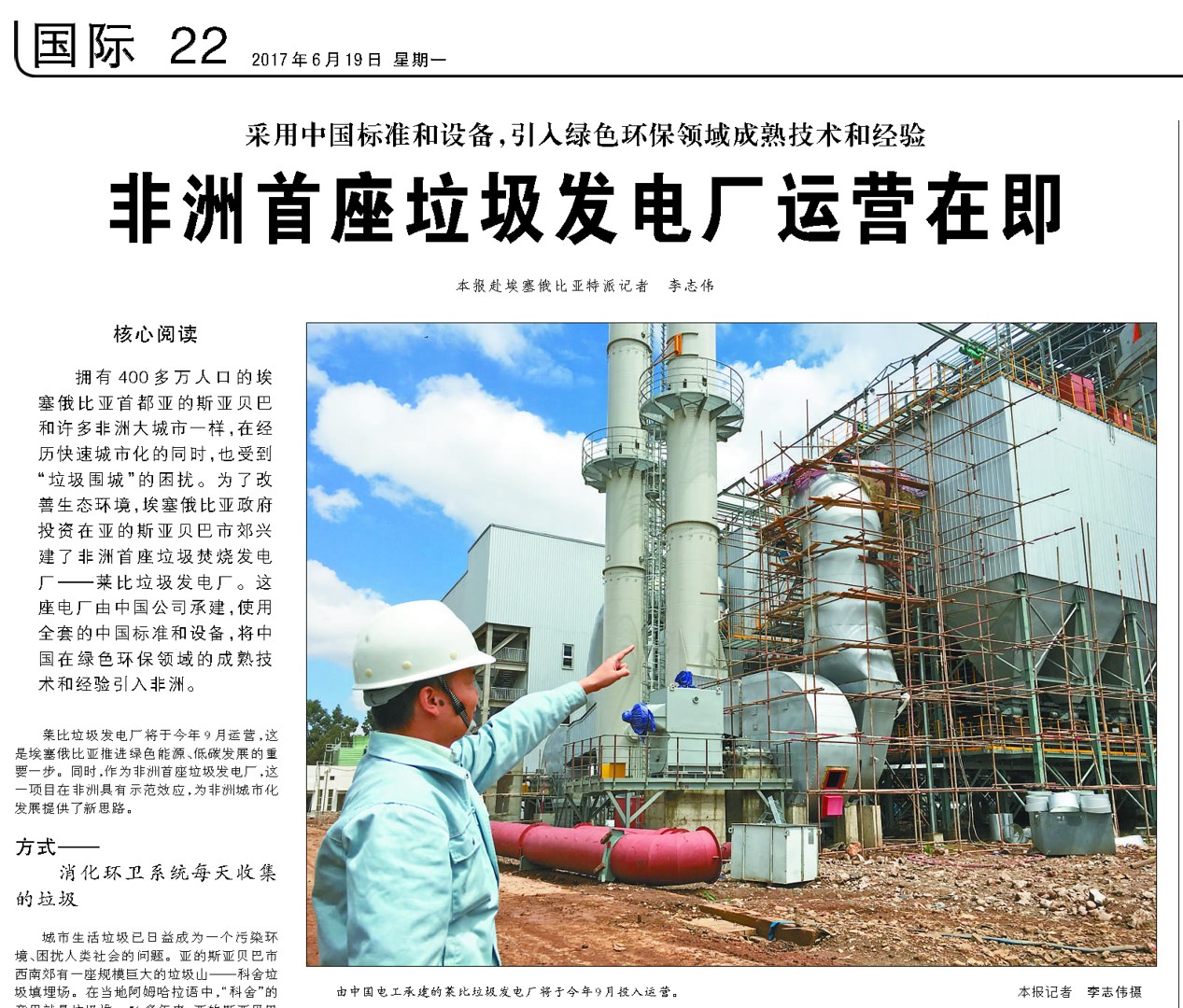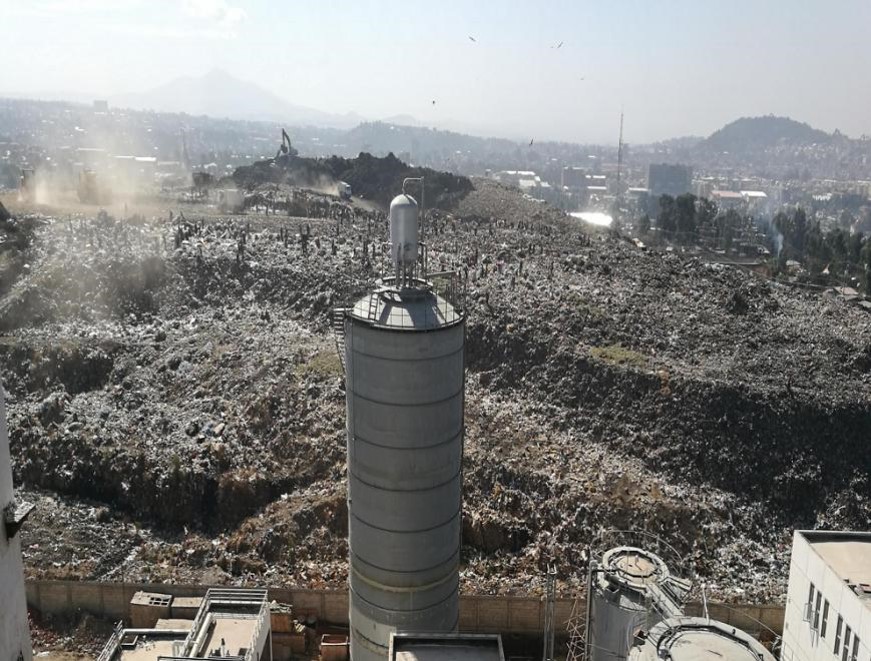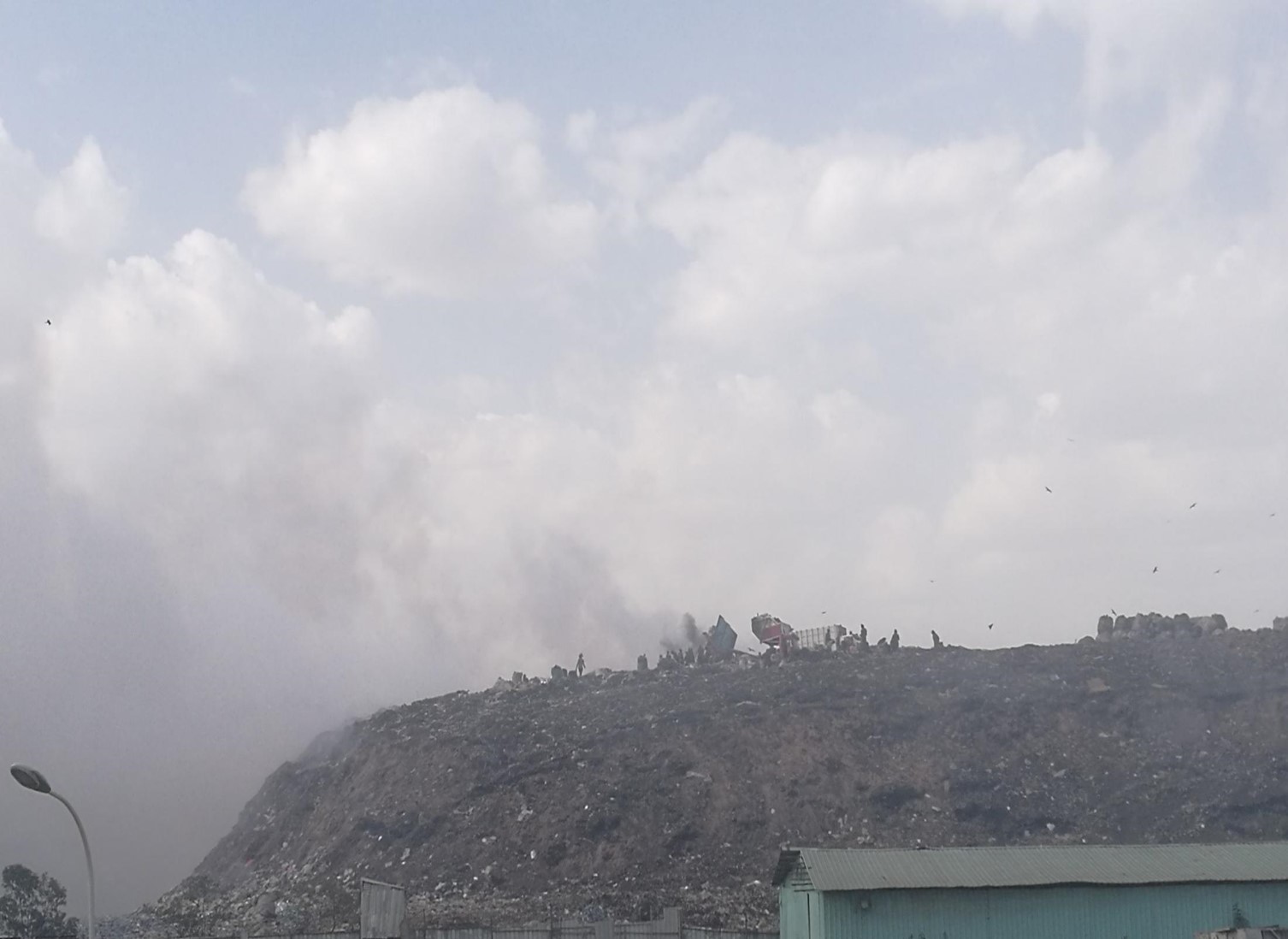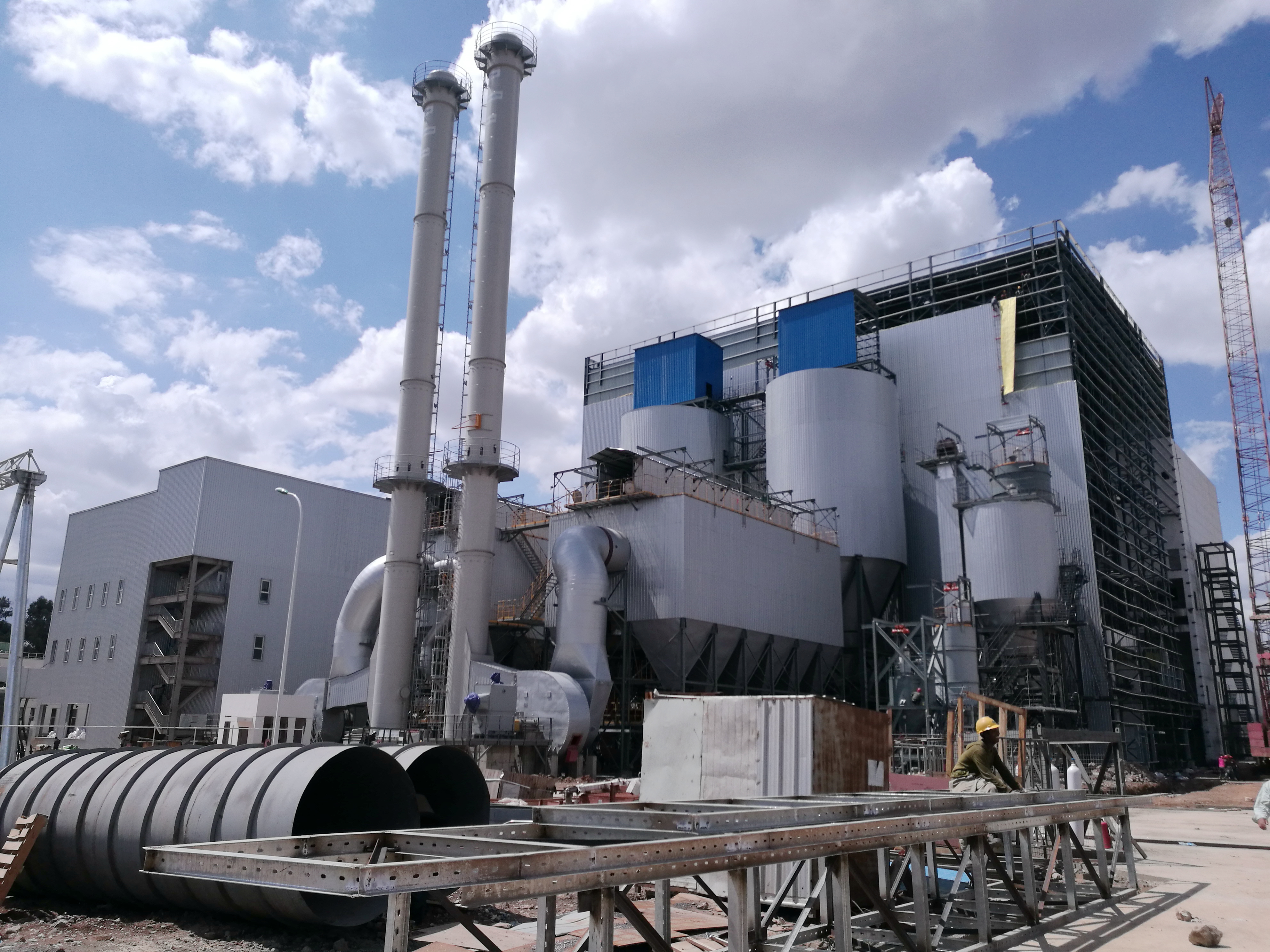“Made in China” on the Roof of Africa—CNEEC Builds Africa’s First Garbage Power Plant
Editor’s note: I’m Wang Haibing from the Third Division of China National Electric Engineering Co., Ltd. In our large CMEC family, there are many people of the same age who have the same experience as me. When I joined the company, I was a jade-faced scholar. I became tanned and wrinkled after a few years. It is another kind of “physical attractiveness” given to us by overseas engineering construction. Everyone knows that it is tough to build power plants overseas. I want to say that it is even harder to build garbage power plants. Today, I will tell you the story of the first “Made-in-China” garbage power plant in Africa.
On June 19, 2017, a special report titled Africa’s First Garbage Power Plant Soon to Be in Operation in the international edition of People’s Daily attracted the attention of many CNEEC people. In the photo, under the blue sky and white clouds, a modern power plant is springing up. Compared with CMEC’s many successful projects, such a small-scale power plant is too common. However, what you can’t imagine is that this power plant was “nurtured” by a hill-like garbage mountain after four years. It is Lebi Garbage Power Station project undertaken by CNEEC in Ethiopia.
Addis Ababa, Ethiopia’s capital, means “fresh flowers” in the local language. However, Addis Ababa, with a population of more than four million, like many big African cities, has experienced rapid urbanization development and was also troubled by “garbage siege.” In the centre of the city, like Tiananmen Square within Beijing’s Second Ring Road, there is a garbage mountain that has been piled up for nearly 50 years. It is called a mountain because it covers an area of 120,000 square meters, is nearly 30 meters high, and is increasing in unlimited increments of millions of tons of garbage every day. The urban cancer has seriously affected local people’s life, economic development, urban construction, social security, and other aspects. In 2013, the Ethiopian government made up its mind to invest in the construction of a garbage incineration power plant.
The CNEEC people committing themselves to making a breakthrough in Ethiopia market have quickly seized this new market opportunity. There must be competition when there is a market. How many domestic and foreign enterprises are eyeing up this project, while the project department has started bidding in an orderly way. The reason why we are psychologically steadfast is that we do have advantages.
CNEEC started early in the field of clean energy. Since the 1990s, CNEEC has successively undertaken a number of representative projects such as Guangdong Huizhou garbage thermal decomposition and power generation project, Shanxi Jincheng 120MW coalbed gas-steam combined cycle power generation project, Thailand rice husk power generation project, Shandong Taishan cement-kiln waste heat flashing power generation project, Beijing Shuangyushu heat supply plant project, Shanghai Weigang blast furnace gas power generation project, and Thailand TPI 60MW garbage incineration power plant. CNEEC has accumulated rich experience in the field of waste incineration. It not only owns national patents for utility models in this field but also has a group of leading experts in the field of domestic waste incineration power generation. By virtue of its technical and talent advantages, the company has won the first garbage power generation project in Ethiopia, or the first garbage power plant in Africa.
In 2013, the Lebi Project commenced smoothly. Whether anyone is willing to go to the site once became a concern of project department leaders. Because leaders know what the project site is like, even if no one is willing to go there is understandable.
The project site was surrounded by garbage hills on three sides. During the dry season, strong winds blew large quantities of garbage into the plant area. During the rainy season, the rain led to the continuous fermentation of the garbage mountain, the foul smell was scattered in every corner of the site, and black sewage accompanied by the rain seeped into the construction area through the courtyard wall. The harsh environment and difficult construction conditions on the site were beyond the imagination of all the staff of the project department.
I know that we do overseas projects, each of which has a lot of difficulties, but the hardship of Lebi site was severe. You can’t imagine the sour taste, nor can you realize how bad the natural and human environment around the site is. Let me tell you three real examples.
Many residents around the site make their living by picking up rubbish. Some scavengers even set fire to the rubbish in order to find metal rubbish more conveniently. Once, the rubbish mountain was lit by junkmen, and black smoke billowed all over the sky, causing many students in a nearby primary school to be sent to the hospital by ambulance due to gas poisoning. During the construction of the project, a landslide occurred in a garbage mountain not far from our project site, resulting in the death of 19 scavengers. At our site, the local poor came in at night to steal and cut three times on the head of a Chinese construction worker. After the incident, the local government sent federal police to the site.
In the face of such difficult and even dangerous conditions, none of the Lebi garbage power generation project department of CNEEC flinched, and every member silently held his post, making contributions. What moved me most was that during the two years of the peak period of the project construction, five young girls from the project department also stationed on site. Their skin color was tanned several times under the scorching sun, and their arms were still marked by various insects and mosquitoes. However, they held onto their positions in a foreign country with courage and strength beyond their peers. Although we were far away from our relatives, the large family of the project department shared weal and woe. Not the loved ones are better than their loved ones. Although we had given up a stable and comfortable life, we were doing something meaningful.
The power plant that we have built to handle 1,280 tons of domestic waste a day is cooperation between China and Ethiopia in the field of environmental protection. It can process the waste collected daily by the entire Addis Ababa urban sanitation system. It is not only a project, but also a new green road for Addis Ababa’s urban development. Also, as Africa’s first garbage power plant, this project has a demonstration effect in Africa and provides new ideas for the development of urbanization in Africa. What we have done is to use a full set of Chinese standards and equipment to introduce China’s full-fledged technologies and experience in the field of green environmental protection into Africa. When we linked our personal hardship with the happy life of the Ethiopian people and China’s strategy of going global, we immediately felt that all our efforts were worthwhile. We stood on the “roof of Africa” with great pride.
After more than four years of construction, the installation of Lebi Project had been completed. During the construction of this power plant, municipal delegations from various African countries had been visiting the project, and they had shown great interest in the project. Ethiopian President Mulatu Teshome said after visiting the site that the Lebi garbage power generation project has been the epitome of Ethiopia’s economic progress in recent years.
Ethiopia and other African countries’ recognition of CNEEC’s Lebi Garbage Power Plant and the concept of garbage incineration power generation have shown that CNEEC could enter the garbage power generation market in Africa. This year, the China-Africa Cooperation Forum Summit will be held in Beijing. At that time, leaders of China and Africa will gather in Beijing to map out a blueprint for China-Africa cooperation in the new era. CMEC, as the leader in the construction of the “Belt and Road” Initiative, is shouldering the historical responsibility of “going global” in promoting the integration of Chinese standards, Chinese technology, Chinese equipment, and Chinese culture. The successful practice of CNEEC in the field of garbage power generation will better help CMEC to fulfill its great mission of “creating a high-quality life for the people of the world.”
Now that I have chosen a distant place, I only care about the non-stop journey, regardless of hardships. CMEC members who are not afraid of difficulties joined in overseas undertakings without complaint or regret. They rush around the mountains and rivers of the world, lighting up “Made in China” with their youth and dedication.

垃圾发电厂新闻报道

垃圾堆积成山

焚烧垃圾

女员工

埃塞总统、中国驻埃塞大师到访

埃塞俄比亚莱比垃圾发电项目





